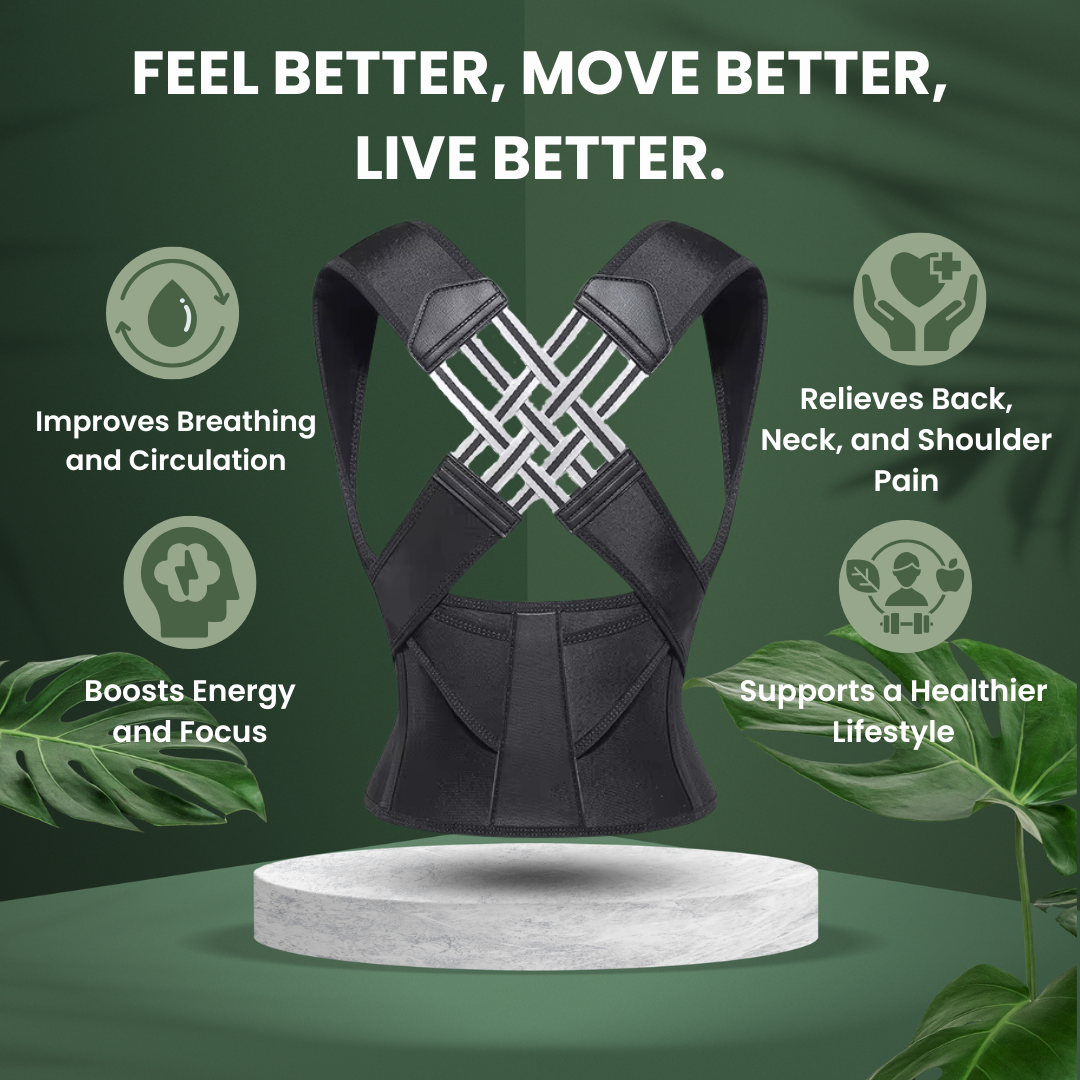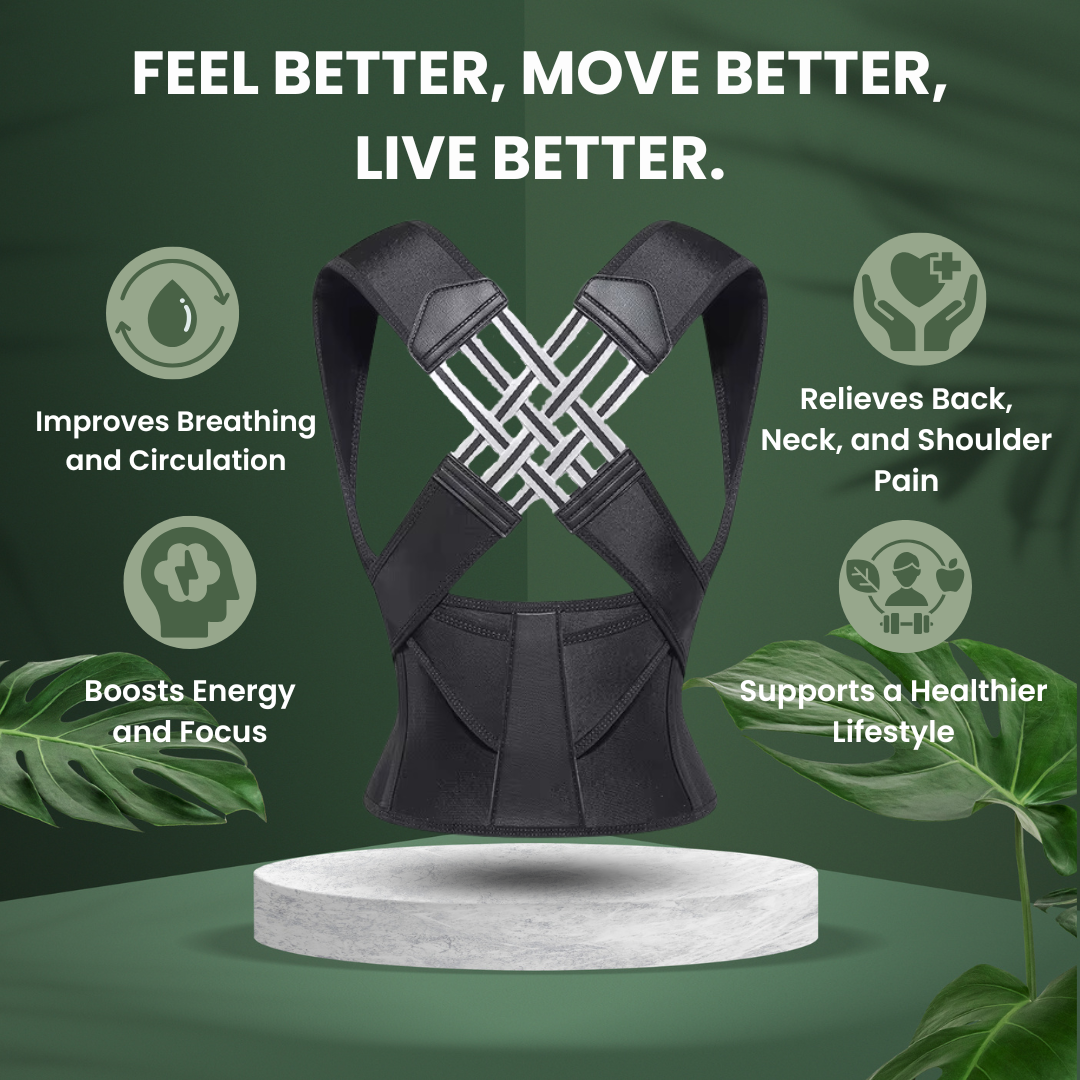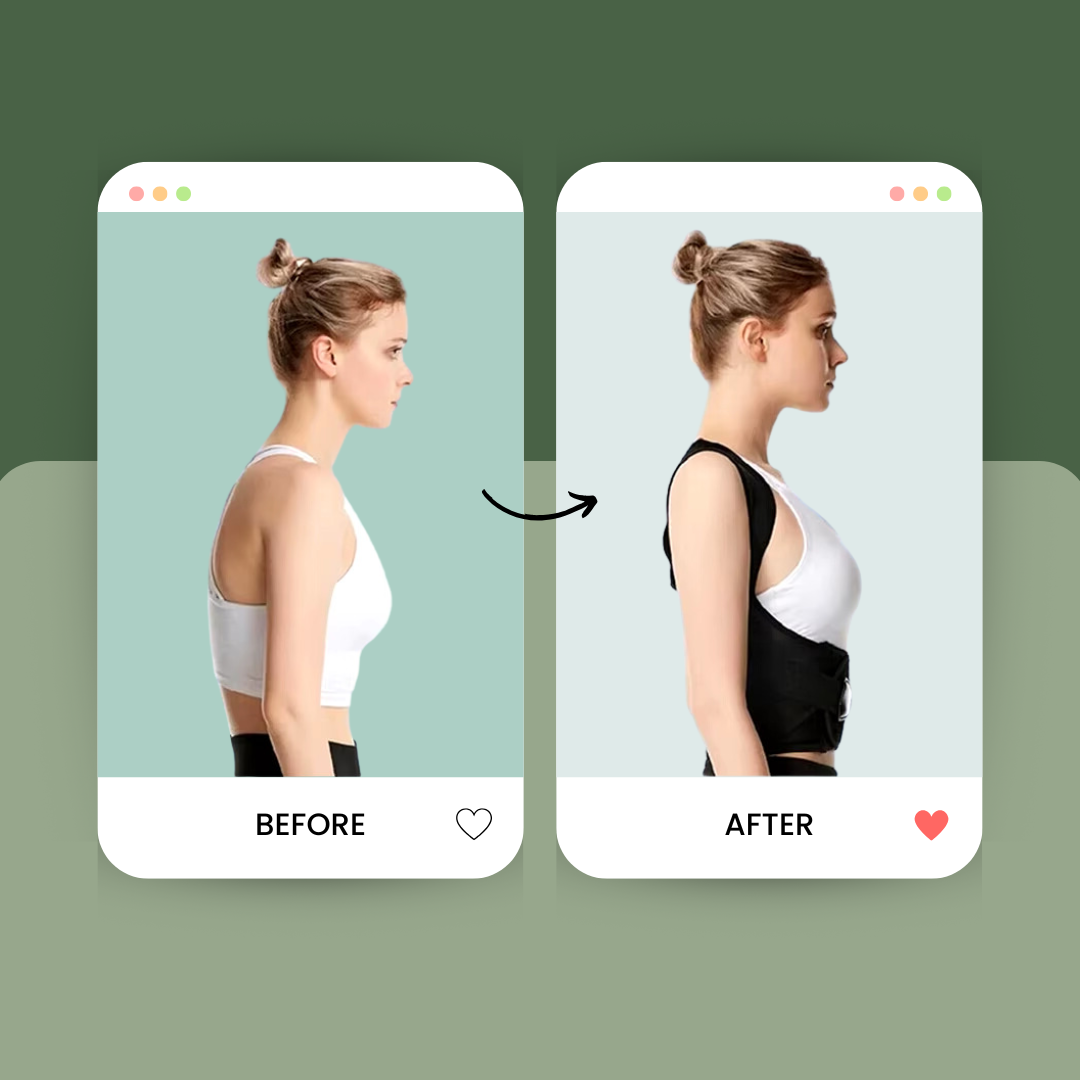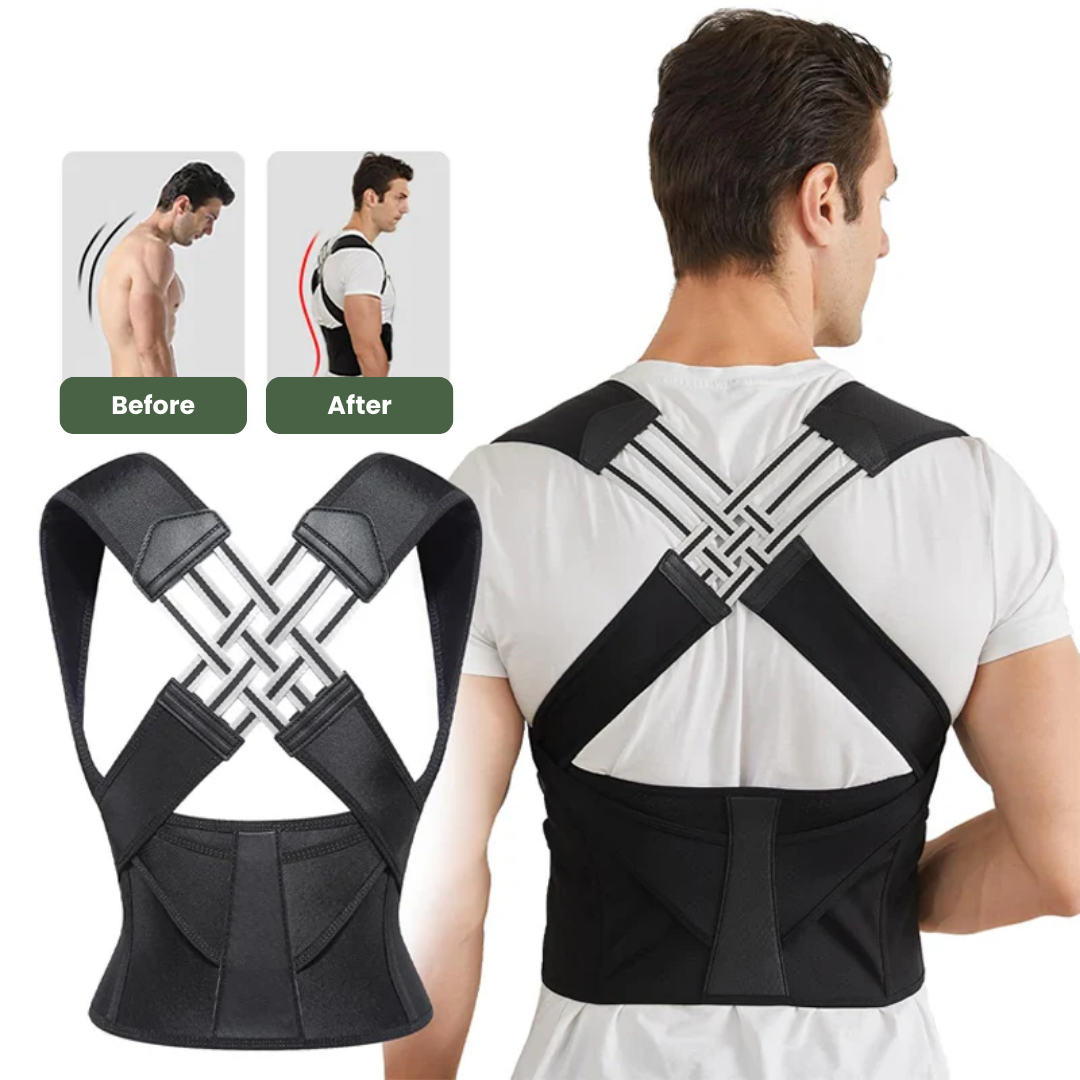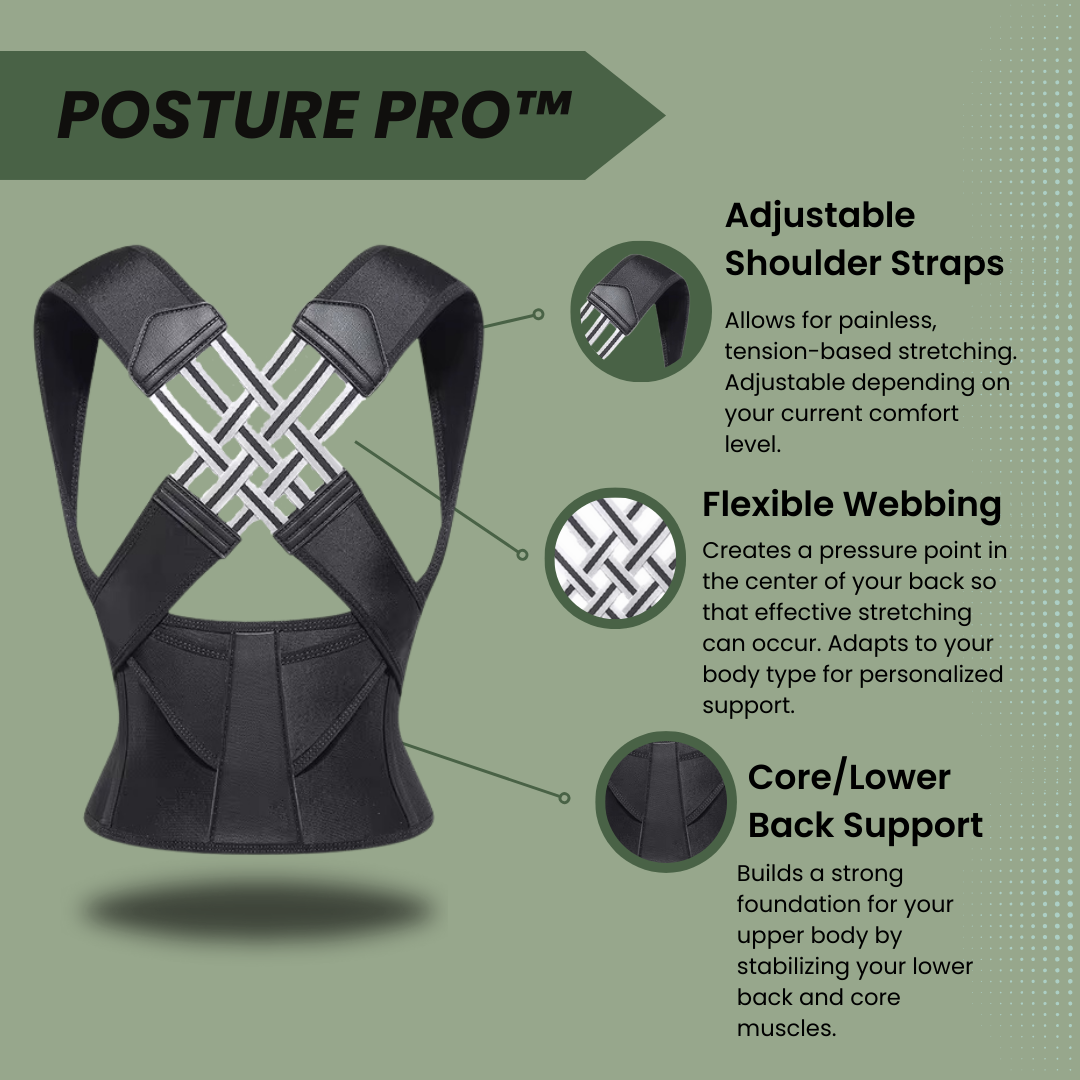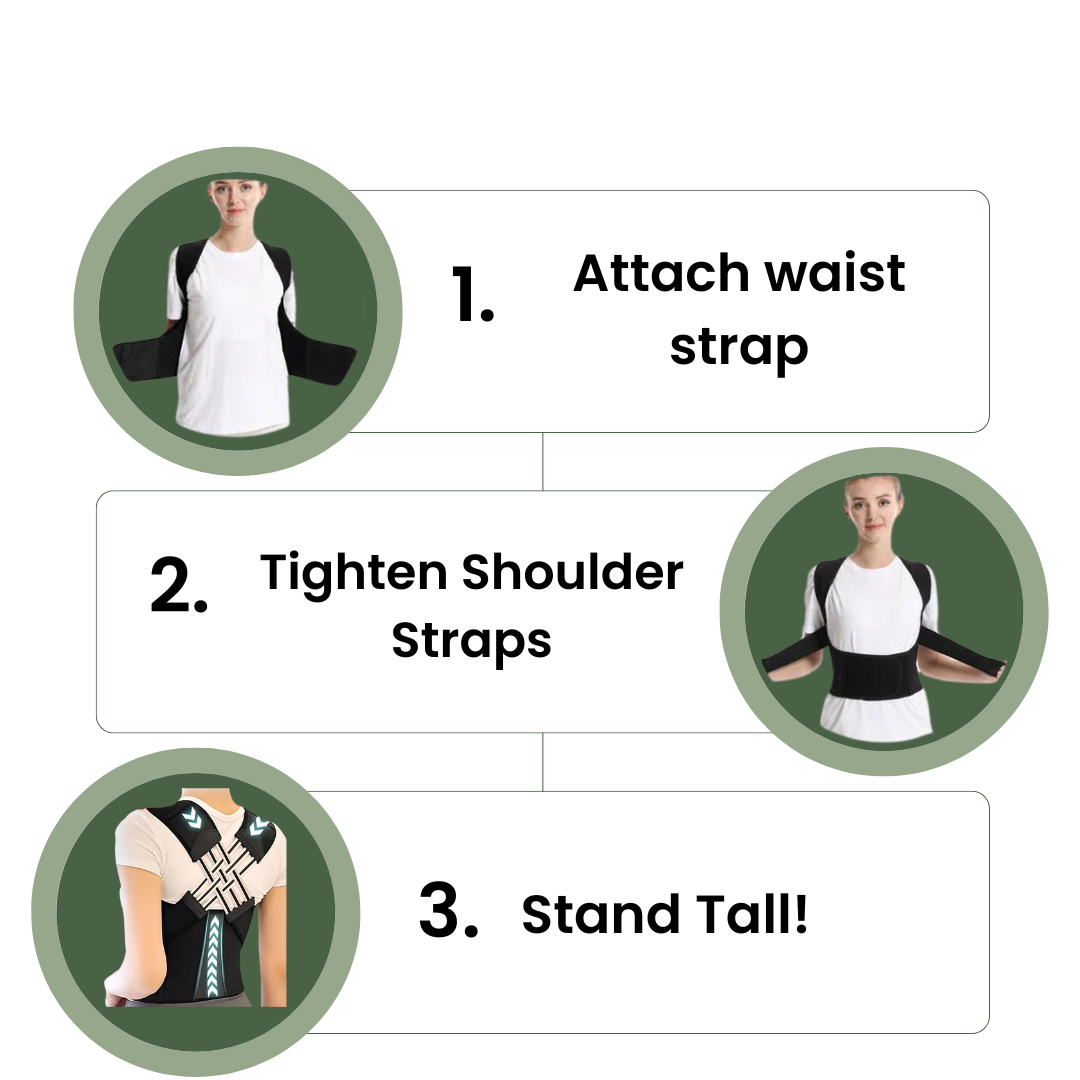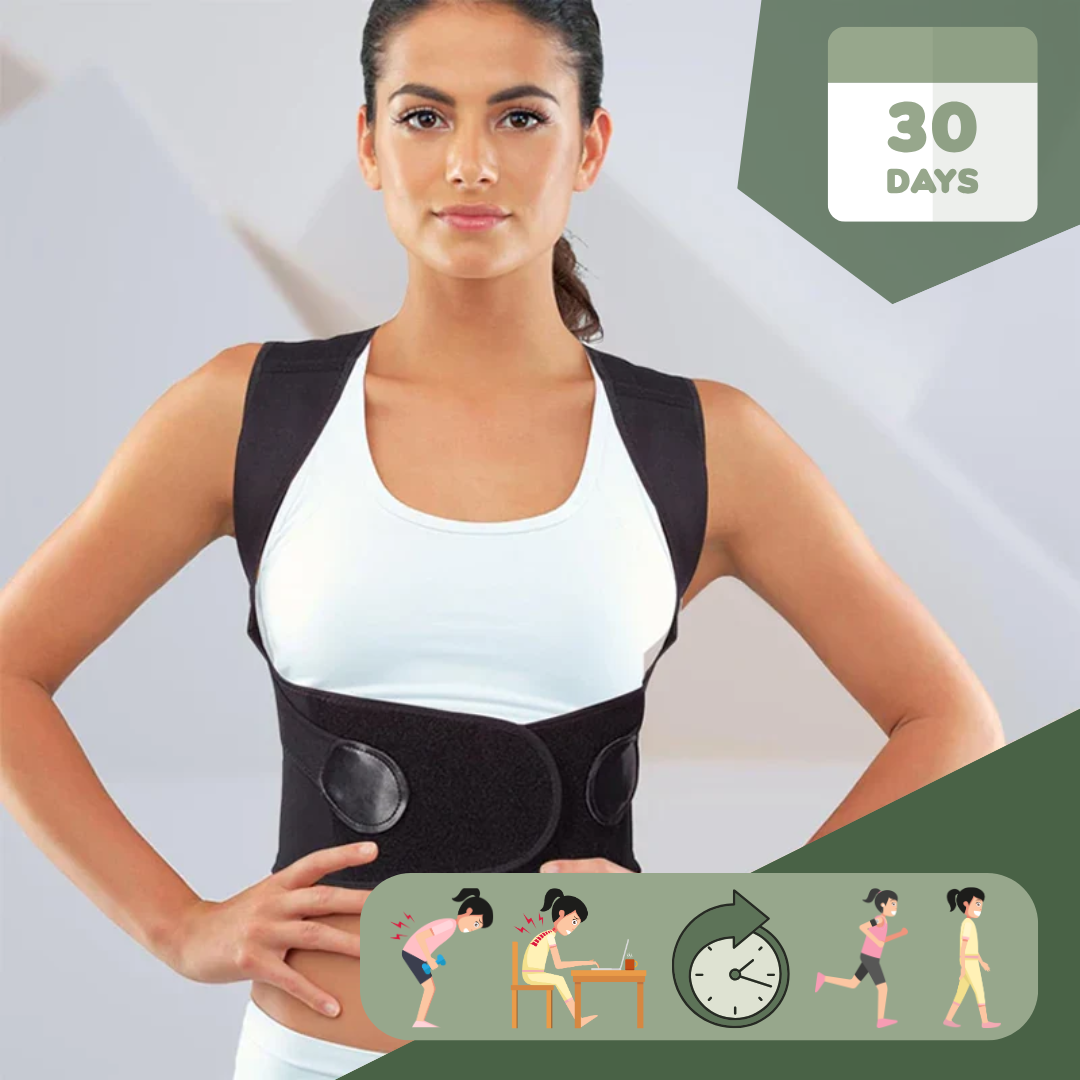Many people struggle with bad posture. Good posture helps your body feel stronger and less tired. This article will show you exercises and tips to fix your posture. Let's get started!
Key Takeaways
- Good posture keeps your spine straight, reducing stress on muscles and joints. This helps avoid back and neck pain.
- Exercises like Child’s Pose, Cat-Cow Stretch, High Plank, and Glute Bridges can strengthen muscles vital for proper posture.
- Sitting too much weakens muscles important for keeping you upright. Take breaks to move around every 30 minutes.
- Make your workspace ergonomic by adjusting the desk height, chair support, monitor position, and keyboard setup to reduce strain.
- Using posture correctors correctly alongside exercises can help improve your stance without making you depend on them too much.
What Is Posture and Why Is It Important?
Posture is how you hold your body when you stand, sit, or move. Good posture keeps your spine in a straight line. This helps prevent common pains like backache and neck pain. Your spine has natural curves that good posture keeps in the right shape.
This makes sure the stress on muscles and joints is small.
Proper posture supports your spine and can help prevent common aches and pains.
Having strong posture matters because it keeps your body healthy. If your posture is bad, you might feel stiff or have headaches. Keeping a healthy position reduces strain on bones and stops injuries.
Each person's proper stance varies due to different body structures, but aiming for balance is key.
Common Causes of Poor Posture
Sitting too much makes your muscles weak. This happens from staying in one place for a long time, like at a desk or watching TV. Weak muscles can't hold you up well. This leads to bad posture.
Muscle weakness comes from not moving around enough and also from injuries or health problems like arthritis.
Bad habits play a big role too. Many people slouch without thinking about it, especially when they use computers or phones. This puts stress on your back and neck muscles. After a while, this stress makes it hard to keep good posture because your body gets used to being out of alignment.
Best Exercises to Improve Posture

Improve your posture with these effective exercises. Read more to learn how they can help you.
Child’s Pose
Child's Pose is a simple yoga move that helps stretch your back muscles, glutes, and hamstrings. Start by sitting on your heels with your knees hip-width apart. Then, lower your belly between your thighs as you reach forwards with your hands.
Place your palms on the floor and stretch out in front of you. Your forehead should gently rest on the ground. This position can be held for up to five minutes, allowing your spine to lengthen and relax.
This exercise is good for people at any fitness level and has many health benefits. It works key muscle groups like the trapezius in the upper back, erector spinae along the spine, latissimus dorsi across the lower back, and hip flexors at the top of your thighs.
Child's Pose calms down nerves too while lowering blood pressure which might help you sleep better at night.
Taking time for exercises like Child's Pose can greatly improve how we feel overall—stretching not just our bodies but easing our minds as well.
Cat-Cow Stretch
Sit on your hands and knees. Breathe in, arch your back, and lift your head - this is the cow stretch. Then breathe out, round your spine, and tuck in your chin - this is the cat stretch.
Repeat these movements slowly for at least 1 minute to boost spinal flexibility and avoid back pain.
Wall Angels
Stand 6 to 9 inches away from a wall with knees slightly bent. Perform 7 to 8 times a day in short sessions of about 20 seconds each. This exercise helps stretch tight muscles and engage core and shoulder blade muscles for better posture.
High Plank
The high plank is an effective exercise that strengthens your shoulders, glutes, and hamstrings. It's also great for improving core strength and posture. When you perform a high plank, different muscles in your body engage including the transverse abdominis, rectus abdominis, obliques, glutes, quads, hamstrings, and calves.
To do this exercise:
1. Start on all fours with your hands directly beneath your shoulders.
2. Step back with each foot until your legs are straight and you're supporting yourself on just your toes and hands.
3. Your body should form a straight line from head to heels.
4. Hold this position for up to 1 minute while engaging your core muscles.
Keep in mind to breathe continuously as you hold the position. This exercise is crucial in building overall body strength while emphasizing core stability.
Bird-Dog
The Bird-Dog exercise targets multiple muscle groups and improves core stability, mobility, and coordination. It engages the deltoids, erector spinae, glutes, and core muscles. This exercise involves balancing on your hands and knees while extending opposite arm and leg parallel to the ground.
Variations may include lifting one limb at a time or adding extra movements like elbow-to-knee touches for added challenge.
This captivating workout can be customized to any fitness level by adjusting the duration of each hold or including additional movements to intensify the exercise. By diligently practicing Bird-Dog exercises along with other effective posture-improving workouts, you can strengthen key muscle groups essential for maintaining proper posture throughout daily activities.
Glute Bridge
The glute bridge is an effective exercise that helps activate and strengthen your glutes, enhancing lower back strength and core stability. To perform the glute bridge, lie on your back with your knees bent and feet flat on the floor.
Lift your hips off the ground until your body forms a straight line from shoulders to knees. Squeeze your glutes at the top of the movement before slowly lowering down. This exercise can be beneficially repeated in 3 sets of 15 repetitions or as 3 rounds of a 30-second hold.
Thoracic Spine Rotation
Improve the flexibility of your upper back and decrease tightness in the spine with thoracic spine rotation. This stretch involves twisting your upper body to each side while seated or lying down, relieving spinal tightness and improving flexibility.
To perform this exercise, sit up straight and cross your arms over your chest. Slowly rotate to one side as far as comfortable, then switch to the other side. Repeat this movement 5-10 times per side to achieve better flexibility and reduce injury risk.
Picture yourself stretching tall with greater ease after incorporating thoracic spine rotation into your routine; you'll notice its positive impact on both posture improvement and overall well-being.
Desk Exercises to Maintain Proper Posture
To maintain proper posture while at your desk, try these exercises:
- Gently stretch your neck by tilting your head from side to side, holding each position for a few seconds.
- Roll your shoulders back in a circular motion to release tension and improve upper body alignment.
Seated Neck Stretch
To maintain a strong and flexible neck, engaging in seated neck stretches is essential. It can help alleviate stiffness and prevent or reduce neck and back pain. The stretch can be performed while seated or standing.
Engaging in seated neck stretches regularly prevents stiffness and sustains strength and flexibility in the neck area.
By including seated neck stretches in your routine, you can alleviate discomfort, improve flexibility, and encourage better posture.
Shoulder Rolls
Shoulder rolls contribute to shoulder relaxation and tension reduction. Performing shoulder rolls against a wall helps maintain proper alignment. This exercise is crucial for addressing rounded shoulders.
Once you notice poor posture, doing shoulder rolls can effectively alleviate discomfort.
Keep in mind the significance of maintaining a balanced and comfortable body during daily activities.
Moreover, regularly performing shoulder rolls trains your muscles to sustain good posture throughout the day.
Chin Tucks
Chin tucks are straightforward yet impactful exercises to enhance posture and relieve neck and shoulder discomfort. To do chin tucks, maintain an upright sitting or standing position, then gently pull your chin towards your throat without tilting your head.
Hold this posture for a few seconds before releasing. Regularly doing chin tucks can help counteract forward head posture and fortify the muscles in the front of your neck.
Incorporating chin tucks into a comprehensive routine of posture-enhancing exercises can be advantageous, as they focus on specific muscle groups that are vital for maintaining proper spinal alignment and reducing strain on the upper back and shoulders.
Lifestyle Changes to Enhance Posture
Make mindful movements a part of your daily routine, using tools around you like standing desks or posture-friendly chairs to support an active lifestyle. To learn more ways to enhance your posture, continue reading our blog.
Mindfulness and Body Awareness
Mindfulness, like observing your breath or practicing Hatha yoga, can help reduce stress. It also improves attention, emotional regulation, and coping strategies for better mental health.
Regular mindfulness practice has been linked to improved immune responses and lower distress levels in various studies.
These practices underpin a deeper connection between the mind and body. Paying attention to how you move and sit can alleviate physical tension and strain. Incorporating mindfulness techniques into daily routines helps maintain good posture by enhancing body awareness and reducing the risk of developing poor habits that lead to discomfort and pain.
Regular Breaks from Sitting
When you sit for extended periods, make sure to take regular breaks. Stand up and move around every 30 minutes. This can help prevent stiffness and keep your muscles engaged. Short walks or stretches will work wonders for your body.
Incorporating low-intensity physical activities into your day is advantageous. Even small activity interruptions, like standing up and stretching for 2-3 minutes, can enhance glucose metabolism.
Implementing these short breaks throughout the day has a substantial positive impact on your health in the long run as well.
Staying Active Throughout the Day
Staying active throughout the day is crucial for maintaining good posture. Regular movement helps to prevent muscle fatigue and improves body alignment, reducing the risk of poor posture-related issues.
Simple activities such as taking short walks, stretching periodically, or doing quick exercises can make a significant difference in your overall posture. Additionally, incorporating standing desks or adjustable workstations into your daily routine provides periodic breaks from sitting and encourages better postural habits.
Keep in mind that making small changes in your daily routine can significantly impact your overall well-being. So, take frequent movement breaks and stay active to maintain a healthy posture throughout the day.
Ergonomic Adjustments for Better Posture
When setting up your workspace, choose a desk and chair that allow you to sit with your feet flat on the floor and knees at a 90-degree angle. Ensure your monitor is positioned at eye level, about an arm's length away to reduce strain on your neck and eyes.
Support your lower back by utilizing a cushion or lumbar roll if your chair does not provide adequate support.
Choosing the Right Desk and Chair Setup
Regarding setting up your workspace, consider selecting a chair that properly supports your spine and enables you to place your feet flat on the floor. This will aid in maintaining correct posture and avoiding strain on your back.
Align the keyboard directly in front of you to ensure that your wrists and forearms align with relaxed shoulders. Additionally, position the monitor at an arm's length away, with the top of the screen at or slightly below eye level to minimize neck strain.
Establishing good sitting habits is recommended, as they contribute to comfort and productivity during the workday.
Proper Monitor and Keyboard Placement
Position your monitor directly in front of you at arm's length, with the top of the screen at or slightly below eye level. This helps to reduce strain on your neck and eyes. Place the keyboard straight in front of you as well to maintain alignment between your wrists and forearms while keeping your shoulders relaxed.
Using an external keyboard and mouse along with a laptop stand can help achieve a more ergonomic setup so that you can work comfortably for extended periods.
When setting up your workstation, ensure that these factors are taken into consideration to avoid discomfort and potential long-term health issues: positioning the monitor at eye level, maintaining straight posture by aligning wrists and forearms, engaging in regular breaks from sitting, staying active throughout the day, using supportive footrests and cushions where necessary.
Supportive Footrests and Cushions
Supportive footrests and cushions are crucial for maintaining good posture while sitting.
By elevating your legs with this support, you can help prevent leg swelling and back discomfort, encouraging improved circulation. Additionally, this support serves as a calf stretcher, providing relief for ailments such as plantar fasciitis and Achilles tendonitis.
By integrating these ergonomic modifications into your workspace, you can significantly boost your overall comfort and well-being.
Tips for Using Posture Correctors Effectively
Here are some tips for using posture correctors effectively:
1. Employ posture correctors for a few hours each day to avoid relying on them excessively.
2. Pair wearing posture correctors with strength-building exercises to enhance muscle memory and body awareness.
3. Slowly reduce the duration of wearing the corrector as your posture improves.
Keep in mind that employing these tips can assist in improving the effectiveness of posture correctors and fostering better overall posture habits.
Conclusion
Improve your posture with simple exercises and lifestyle adjustments. Good posture can reduce muscle pain, increase energy, and even enhance positive feelings. Regular exercise, ergonomic support, and mindful habits can make a big difference in your overall well-being.
So start today and take small steps to improve your posture for a healthier and more energetic you!
FAQs
1. What are some exercises that can improve posture?
Exercises like strength training, abdominal exercise, yoga postures and flexing your shoulder muscles or back muscles can help improve posture. These target areas such as the abdomen, upper arms, gluteus maximus and pelvic bone to strengthen them.
2. How does a physical therapist aid in improving posture?
A physical therapist provides guidance on correct form for various exercises that work on specific muscle groups - from your biceps to lumbar lordosis rehab. They ensure you're not straining any part of your body while working towards better posture.
3. Can breathing techniques also influence good posture?
Yes indeed! Taking deep, controlled breaths helps keep the shoulder blades relaxed which is essential for maintaining an upright position.
4. Is there scientific evidence supporting these tips and exercises for improved posture?
Absolutely! A systematic review of various studies has highlighted the positive impact of these methods on improving one's stance.
5. Are there any quick daily habits I can adopt for better posture?
Sure thing! Simple actions like ensuring proper alignment between your ankle and pelvic bone when standing or sitting could make a significant difference over time.



